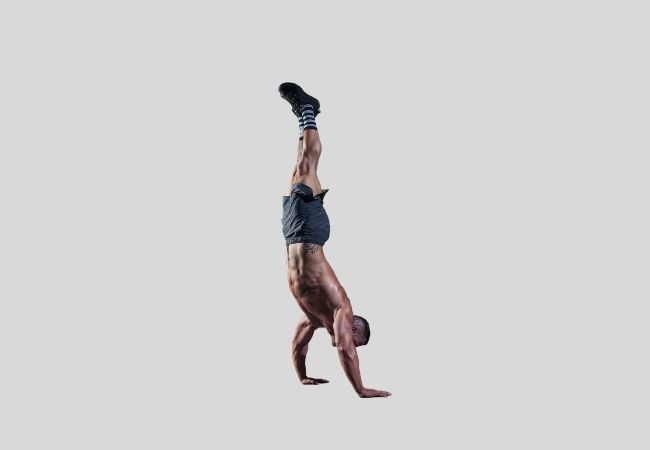Holding handstands for extended periods requires immense shoulder, core and grip endurance. While reaching long-held goals may seem unattainable initially, dedicated training and patience allow continual progression so yoga practitioners and gymnasts can gracefully achieve beautiful, extended handstands. In this article, we will try to teach how to hold a long handstand
Table of Contents
The Benefits of Longer Handstand Holds
Increasing handstand hold time provides many advantages:
- Builds shoulder and core muscular endurance over time
- Challenges and improves overall balance ability
- Enhances concentration skills and body control
- Provides a great sense of achievement upon reaching time goals
How To Hold A Long Handstand
Proper Handstand Form and Technique
Maintaining proper form is crucial when pursuing longer holds:
- Shoulders stacked above wrists for alignment
- Straight arms with engaged muscles to support position
- Hollow body engagement through the core
- Raised chest and vertically aligned legs
- Controlled breathing provides internal focus
With proper form, extended handstands can avoid injury or lack of grace. Master solid technique before chasing long holds.
Related: 9 Effective Tips For Yoga Handstand
Training the Shoulders for Endurance
Dedicated shoulder training prevents fatigue:
- Perform weighted and extended wall handstand holds
- Include targeted isometric exercises like planche leans
- Build strength through moves like downward dog and handstand pushups
- Ensure adequate overhead mobility and rotator cuff stability
Solid shoulder strength and endurance enable maintaining proper handstand positioning for extended periods.
Building a Strong Core
A braced, conditioned core supports long holds:
- Train hollow body and L-sit positions
- Include core moves like planks, dead bugs and leg lifts
- Practice holding tension for time to build engaged endurance
- Develop breath control by bracing and segmental breathing
Balance skills are only meaningful with the core to hold a rigid position long-term.
Developing Balance Skills and Control
Reducing reliance on the wall develops balance:
- Slowly remove wall support as skills progress
- Practise single-leg kick-ups to isolate each side
- Add transitional moves like pirouettes or straddle presses
- Use spotting for support and to reduce fear of falling
Finesse balance abilities through targeted drills before pursuing endurance goals.
Remaining Patient and Focused
Extending holds requires dedicated practice over time:
- Remain consistent in training sessions each week
- Celebrate small achievements to maintain motivation
- Cultivate mental focus and calm breathing
- Know your limitations and need for rest to prevent overtraining
Rushing the process risks injury. Have patience and focus on gradual gains.
Tips for Holding Longer Handstand
Use these strategies for tangible progress:
- Master solid handstand form and technique first
- Dedicate training sessions focused only on time extensions
- Record sessions to track quantitative progress
- Use wall support or spotting to reduce fatigue as needed
- Take sufficient rest days to allow for shoulder and core recovery
Related: Chest To Wall Vs Back To Wall Handstand
Avoiding Burnout and Overtraining
Listen carefully to prevent pushing too far:
- Heed body signals like pain, fatigue or sickness
- Prioritise sleep and nutrition to enable recovery
- Reduce training intensity and volume if feeling overworked
- Respect needed rest days after intense sessions
Pursuing endurance goals without allowing proper rest leads to regression.
A Word From Blogzah
Holding beautiful, extended handstands is an impressive feat of strength, balance and mental focus. However, it requires immense dedication and training to achieve safely and effectively. There are several key factors to keep in mind:
First, proper form and technique must be mastered before pursuing endurance goals. Attempting long holds without proper shoulder stacking, engaged core, and vertical alignment will lead to injury or lack of poise. Dedicate ample time upfront solely focused on perfecting the handstand technique. Film sessions regularly to check for form errors.
Second, targeted supplemental training prepares the muscles and joints for the demands of extended holds. Handstand-specific drills like weighted wall hold, planche leans, and kick-up reps build essential strength. General shoulder and core conditioning boosts endurance. Proper recovery time must be programmed into the schedule.
Third, progress requires immense patience and consistency without rushing or skipping steps. Set small, incremental hold time goals like 5-10 seconds additional per week. Record sessions to track quantitative progress. Celebrate small gains to maintain motivation on difficult days. Remain patient through inevitable plateaus.
Fourth, use wall support, spotting and other aids judiciously to reduce fatigue while building independence. Controlled negatives and supplemental balance drills develop true poise and stability.
Finally, listen carefully to the body’s signals to avoid overtraining. Take rest days whenever fatigue or pain arises. Prioritise sleep, nutrition and recovery. Handstands are a challenging journey requiring self-compassion.
With mindful dedication and training, yoga students can utilize these strategies to progressively extend their inversion hold times and achieve impressive, graceful handstand endurance over time. The process brings immense rewards.
















